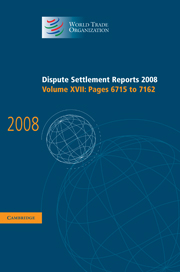Report of the Panel – Annexes F and G
from Canada – Continued Suspension of Obligations in the EC – Hormones Dispute (WT/DS321)
Published online by Cambridge University Press: 13 December 2017
Summary
ANNEX F-1
COMMENTS BY THE EUROPEAN COMMUNITIES ON THE REPLIES OF THE SCIENTIFIC EXPERTS TO QUESTIONS POSED BY THE PANEL (30 June 2006)
General Definitions
Q1. Please provide brief and basic definitions for the six hormones at issue (oestradiol-17β, progesterone, testosterone, trenbolone acetate, zeranol, and melengestrol acetate), indicating the source of the definition where applicable.
EC Comments
Dr. Boisseau's reply does not consider any progress in toxicological knowledge concerning these hormones, and in particular estradiol, since the 70th and 80th JECFA reports. Since then new data concerning residues in tissue and their toxicological impact have been published. In his answer, he has only adopted a narrow regulatory definition. More specifically, as regards oestradiol, aromatization of androgens in estrogens is also very significant in adipose tissue. In his definitions, the sites of production in the human body is limited to the primary source and does not dwell on variability over the life span of an individual. Furthermore, his definition does not stress that Zeranol is a very potent estrogen. Zeranol is not a “natural estrogen” that humans are exposed to. In fact, great care should be taken to avoid the presence of fusarium molds in animal feed and especially in products for human consumption. As regards the implantation of these hormones, he uses simple present tense (“the ear is discarded”) when precisely this is not known nor it is sure that it happens in practice in all cases. He should therefore have said that “the ear should be discarded at slaughter”.
- Type
- Chapter
- Information
- Dispute Settlement Reports 2008 , pp. 6717 - 7162Publisher: Cambridge University PressPrint publication year: 2010

